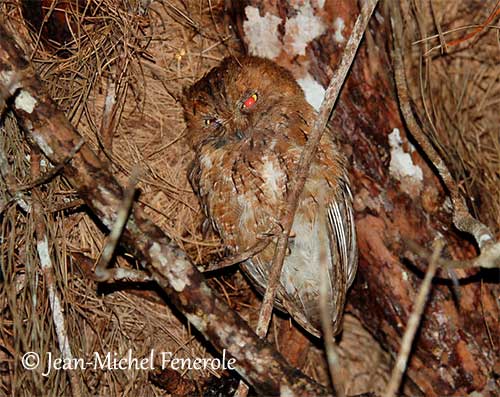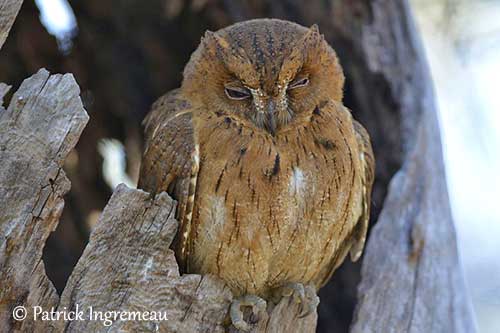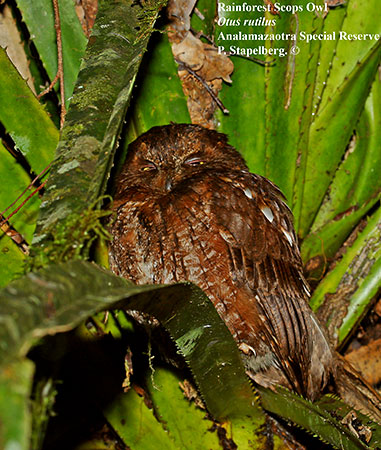
PROTECTION / THREATS / STATUS:
The Rainforest Scops-Owl is locally fairly common in suitable habitat. The species is common to abundant in forested areas, but it is rare in woodlands in the high plateau. It is present in several protected areas.
The size of the population is unknown, but it is suspected to be stable.
The Rainforest Scops-Owl is currently evaluated as Least Concern.
Fr: Petit-duc Malgache
Ang: Rainforest Scops-Owl
All: Madagaskar-Zwergohreule
Esp: Autillo Malgache
Ita: Assiolo del Madagascar
Nd: Oostelijke Madagaskardwergooruil
Sd: östlig madagaskardvärguv
Mal: Fataliha, Fitaliha
Photographers:
Jean Michel Fenerole
Photos d’Oiseaux du monde
Patrick Ingremeau
TAMANDUA
William Price
PBase-tereksandpiper & Flickr William Price
Philip Stapelberg
GALLERY
Text by Nicole Bouglouan
Sources :
HANDBOOK OF THE BIRDS OF THE WORLD Vol 5 by Josep del Hoyo-Andrew Elliott-Jordi Sargatal - Lynx Edicions - ISBN: 8487334253
BIRDS OF PREY OF AFRICA AND ITS ISLANDS by Alan and Meg Kemp - Struik Publishers - ISBN: 1770073698
OWLS OF THE WORLD – By Claus König, Friedhelm Weick and Jan-Hendrik Becking - IBSN 978-0-7136-6548-2
The Birds of Africa: Volume VIII: The Malagasy Region: Madagascar, Seychelles, Comoros, Mascarenes - Par Roger Safford, Frank Hawkins – ISBN: 1408190494, 9781408190494- Editeur: A&C Black, 2013
Owls of the World - A Photographic Guide: Second Edition Par Heimo Mikkola
Hotspot Birding – Malagasy Scops-Owl
Wikipedia, the free encyclopaedia
Rainforest Scops-Owl
Otus rutilus
Strigiformes Order – Strigidae Family
INTRODUCTION:
The Rainforest Scops-Owl is endemic to Madagascar where it is found in a large part of E Madagascar. It is now considered a monotypic species, but the exact limits of the distribution between its range and that of the Torotoroka Scops-owl (O. madagascariensis) is not well known. Both were formerly conspecific and the status as separate species is sometimes rejected by some authors because the genetic distance between the two taxa is insignificant.
The Rainforest Scops-Owl frequents humid tropical forest and bush. It typically feeds on invertebrates and small vertebrates like most Strigidae species. It hunts mainly at night and rests during the day, well-hidden in tree hole or foliage.
The Rainforest Scops-Owl is usually common in suitable habitat and occurs in several protected areas.

The rufous morph is tinged rufous overall, and the black markings are sometimes indistinct.
The grey morph is similar with more greyish ground colour.
Male and female have similar plumage, but the female is heavier than male.
The juvenile resembles adult.
RANGE:
The Rainforest Scops-Owl occurs in N and E Madagascar.
HABITAT:
The Rainforest Scops-Owl frequents the rainforest, primary and secondary forest, thickets, humid bushy country and urban parks, but it avoids plantations.
This species can be seen from sea-level up to 1,800 metres of elevation or possibly higher.
The rufous morph is common only in rainforest habitat.
CALLS AND SONGS: SOUNDS BY XENO-CANTO
The Rainforest Scops-Owl gives a rapid series of 4-10 short, clear hoots “bruu bruu bruu bruu” fading at the end, with several seconds between two series. We can also hear a harsh “k-r-r-k” repeated a few times.
It calls with the head forwards, sometimes several hours before dusk. It usually calls from high perch in the canopy, or lower down in thickets.
BEHAVIOUR IN THE WILD:
The Rainforest Scops-Owl feeds primarily on insects such as moths, beetles, grasshoppers and also spiders. It probably takes some small vertebrates too.
It hunts at night from perch, catches moths on the wing, and takes other food items on the ground. It flies from tree to tree to hunt insects. It is strictly nocturnal.
It roosts during the day among the foliage or in tree holes and crevices, usually low down and even on the ground among fallen trees.

The breeding behaviour of the Rainforest Scops-Owl is unknown. It nests in tree holes. They are usually monogamous with long-term pair-bonds, a common fact in Otus species.
The Rainforest Scops-Owl is sedentary.
Like all Strigidae species, is has silent flight. It may fly by day is flushed or disturbed. It flies over short distances with direct flight and rapid wingbeats.
REPRODUCTION OF THIS SPECIES:
The nesting period is documented in November and December.
The Rainforest Scops-Owl nests probably in tree holes and other natural cavities. The same nest-site is often reused year after year, and the cavity is maintained very clean.
The female lays 3-4 white eggs and incubates alone. The male hunts and provides her food, including after the hatching of the chicks.
DESCRIPTION OF THE BIRD:
Biometrics:
Length: 19-22 cm
Wingspan: 53 cm
Weight: 85-120 gr
The Rainforest Scops-Owl has three morphs, grey, brown and rufous, and several intermediates.
Crown and upperparts are grey-brown to brown, often with rufous tinge, pale buff spots and narrow black streaks. The scapulars show black-edged white spots. Tail and flight-feathers are barred.
The underparts are paler but conspicuously streaked black, and with indistinct vermiculations. Centre of breast and belly can be sometimes uniformly whitish.
On the head, the facial disk is whitish-brown with dark brown ruff, and it is darker around the eyes. The eyebrows are white and the ear-tufts are fairly small.
Bill, cere and feet are greyish-brown. The tarsi are feathered to toes. The eyes are yellow.

